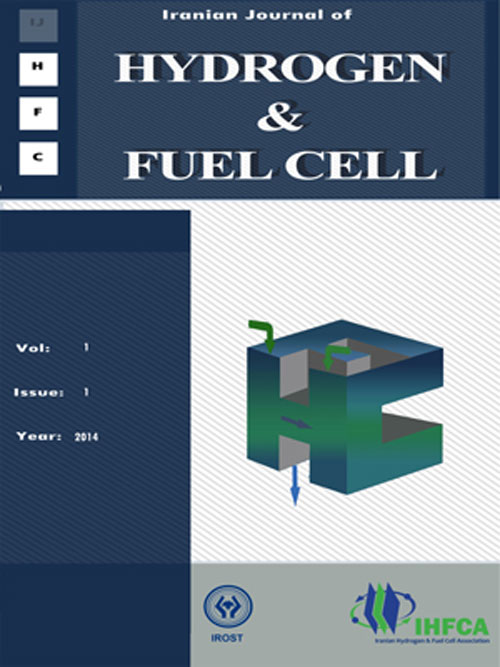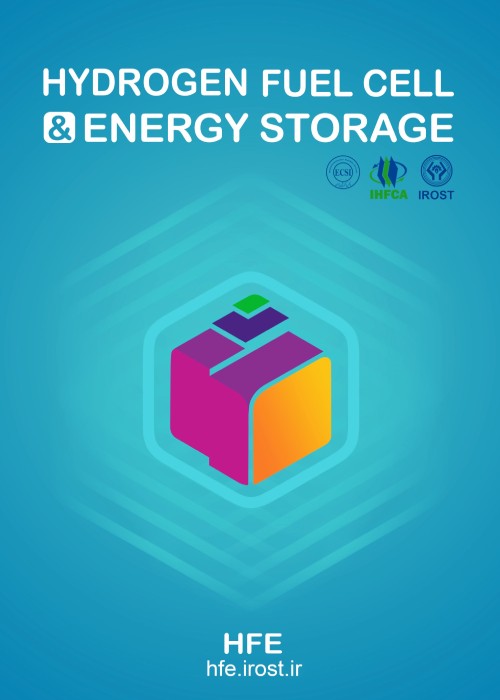فهرست مطالب

Journal of Hydrogen, Fuel Cell and Energy Storage
Volume:4 Issue: 3, Summer 2017
- تاریخ انتشار: 1396/09/30
- تعداد عناوین: 6
-
-
Pages 175-188Increasing efficiency and decreasing cost are the main purposes in the design of the power generation systems. In this study two hybrid systems: solid oxide fuel cell (SOFC)-gas turbine (GT) and SOFC-GT-steam turbine (ST); are considered. Increasing the SOFC input temperature causes thermodynamics improvement in the hybrid system operation. For this purpose, using two set of SOFC reactants heat exchangers (primary heat exchangers and secondary heat exchangers) are recommended. Selection of The primary heat exchangers output temperature and therefore the secondary heat exchangers input temperature (heat exchangers mid-temperatures) influences on the thermodynamics and economics operation of the hybrid system. This work shows that the annualized cost (ANC) and the levelized cost of energy (LCOE) act in conflict with each other. The MatLab genetic optimization algorithms are used to obtain the optimum solutions. The maximum achievable efficiency is 0.599 and the minimum LCOE is 0.0163 $/kWh. Also results show that the heat exchangers mid-temperature of air has the main role in the operation of the hybrid system.Keywords: multi-objective optimization, SOFC, Gas turbine, Steam Turbine, heat exchanger
-
Pages 189-199In this article a new structure of PEM fuel cell end plate is presented. The new structure is known as a honeycomb sandwich panel. Several properties of the presented structure, such as mechanical and thermal behavior, as well as its advantages and disadvantages are introduced. The aim of this paper is to reduce the weight of the while maintaining a better compression force on the PEM fuel cell components. By considering a honeycomb sandwich panel, this structure has lighter weight and more strength and flexibility. In this regard, some mechanical experiments and electrical simulations have been done on the honeycomb structure end plates to provide a comparisom between this new structure and the old structure usually made of steel. These mechanical experiments include pressure and bending tests. The results were evaluated in two cases: with foam and no foam. After analyzing the experimental results, it has been concluded that the honeycomb sandwich panel structure for end plates has many advantages that makes it a good alternative to the old endplate structure.Keywords: PEM fuel cell, End plate, Honeycomb, Optimization
-
Pages 201-207Platinum particles were grown directly by an electrodeposition process on electrochemically treated carbon paper (CP) for kinetic study of carbon monoxide (CO) desorption. The treatment on CP was performed by applying −2 V for cathodic oxidation over 5 min. Treated CP was characterized by FTIR to investigate the oxygen groups on its surface. CO surface coverage at each temperature was determined by monitoring changes in Had (adsorbed hydrogen) desorption charge during CO stripping at different desorption times (300 to 1800 s). CO coverage of the cathodic electrode is lower than non-treated one in all temperatures. Desorption rate constants were calculated for cathodic and non-treated electrodes. From 25 to 85 °C, rate constants for cathodic electrode are higher than the non-treated electrode at all temperatures. The activation energies for desorption, estimated from data obtained by the experiments, are 28480 and 18900 J.mol-1 for non-treated and cathodic electrode, respectively. This shows that CO desorption is easier on the surface of the cathodic electrode than non-treated electrode due to the presence of oxygen surface groups.Keywords: Cathodic treatment, carbon paper, CO Poisoning, Kinetics Desorption, PEM fuel cell
-
Pages 209-218The spin-polarized calculations in generalized gradient approximation densityfunctional theory (GGADFT) have been used to show how the existence of second metals can modify the atomic hydrogen adsorption on Au (100), Cu (100), and Pt (100) surfaces. The computed adsorption energies for the atomic hydrogen adsorbed at the surface coverage of 0.125 ML (monolayer) for the monometallic Au (100), Cu (100), Pt (100) and bimetallic Au@Cu (100) and Au@Pt (100) surfaces are 3.98, 5.06, 4.13, 5.30, and 6.36 eV, respectively. Due to the adsorption of hydrogen atoms, the Au atoms of Au (100), Cu atoms of Cu (100), and Pt atoms of Au@Pt (100) surfaces tend to lose the 6s1, 4s1, and 6s1 electrons and reach the 5d10, 3d10, and 5d9 electronic configurations, respectively. In Pt (100), Au@Cu (100), and Au@Pt (100) systems, the spin-up and spin-down bands are asymmetric and shift significantly in opposite directions. Therefore, they are spin polarized; spin paramagnetism is also observed.Keywords: Hydrogen adsorption, Au (100), Cu (100), Pt (100), DFT
-
Pages 219-230Sulfonated polyether ether ketone (SPEEK) is categorized in a nonfluorinated aromatic hydrocarbon proton exchange membrane (PEM) group and considered as a suitable substitute for common per-fluorinated membranes, such as Nafion, due to wider operating temperature, less feed gas crossover, and lower cost. Since modeling results in a better understanding of a phenomenon, in this study a dynamic one-dimensional model of the membrane electrode assembly (MEA) of this membrane is developed. The model includes both gas and electrolyte phases. Species transfer by diffusion and convection in an intra-phase and interphases space and participate in electrochemical reactions. The catalyst layers are modeled in detail with catalyst agglomerates covered with a layer of electrolyte and feed gas transfers into the electrolyte phase by Henrys low. Then the gas diffuses to the catalyst surface on which it reacts electrochemically. The polarization curve of this MEA obtained from the model is validated against experimental data and shows acceptable agreement. Concentration profiles in the MEA both in the gas and electrolyte phase with time are also presented as results.Keywords: Hydrocarbon proton exchange membrane, fuel cell, SPEEK, Modeling, Dynamic
-
Pages 231-240In the work presented here, nitrogen and sulfur co doped on porous graphene was synthesized using pyrolysis at 900°C for 2h and the hydrothermal technique at 180°C for 24h as metal-free electrocatalysts for oxygen reduction reaction (ORR) under alkaline conditions. All the materials have been characterized by Scanning Electron Microscopy (SEM) and X-ray photo-electron spectroscopy (XPS). Moreover for electrochemical evaluation of samples, Rotating Disk electrode (RDE) and Cyclic Voltammetry techniques (CV) were employed. The results showed that co-doping of S and N into porous graphene significantly enhance the ORR performance. Moreover, it is revealed that the catalyst prepared by the pyrolysis method shows outstanding catalytic activity for the ORR for which the number of electron in the pyrolysis method was calculated to be 4.1; whereas it became 2.6 in the hydrothermal approach.
So regarding the obtained results, it can be stated that the samples prepared through the pyrolysis method exhibits excellent resistance towards methanol crossover effects, indicating their promising potential as ORR electrocatalysts for alkaline fuel cells.Keywords: Co-doped graphene, Metal-free catalyst, Oxygen reduction reaction


